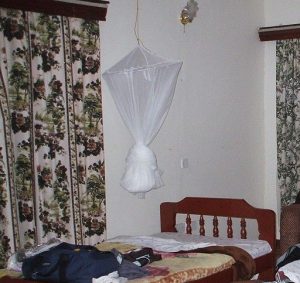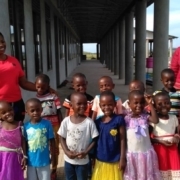Healthcare in Bushasha
There are a variety of serious diseases endemic to Tanzania, and to the Bushasha area in particular, but a lot of effort is being made through public health programs to meet the challenges these diseases present. In fact, the current state of healthcare in the village appears in many respects better than the state of education. This may be a reflection of the large amount of outside support for healthcare in the country as a whole. According to a USAID-funded Health Policy Project report, 48% of Tanzania’s total health expenditures in 2011/2012 were financed by foreign donors.
Village Medical Facilities
The village of roughly 5,000 people has a medical center which includes a daily clinic where villagers can go for simple treatments and medications, and an overnight unit primarily for maternity services. The overnight unit has a solar power system to provide lighting at night. The center has a large cement rainwater collection tank which they treat and use as a water supply for their facility. There is also a staff house for medical center personnel. These health workers do extensive outreach in the community, visiting homes to provide vaccinations and preventative medications as necessary to young children. They also make periodic visits to the local primary school to provide routine preventative medications.
Malaria
Malaria is a major health concern in the village. Residents in all parts of Tanzania are at risk for contracting malaria, with an incidence rate of 113 per 1,000 population in 2015.* In the Kagera region where Bushasha is located, the prevalence is significantly higher than this national average. Malaria transmission occurs throughout the year, although the risk is elevated following the rainy seasons, which extend from roughly October through December and March through May.

Entebbe guest house bed and mosquito net
In recent years the Tanzanian government, outside aid organizations, and programs such as the US President’s Malaria Initiative have been making a combined effort to combat malaria in Tanzania. One important tool in this effort is insecticide treated nets (ITNs)—mosquito bed-nets treated with insecticides that kill and also repel mosquitoes. The insecticides used are generally pyrethroid insecticides, which kill insects but present minimal health risks to humans and other mammals. The World Health Organization recommends free, mass distribution of ITNs for effective malaria prevention. One technique that has been used in the Kagera region is distribution of ITNs at primary schools for children to take home for their families.
Another tool in the fight against malaria is indoor residual spraying (IRS). In 2016 a spraying program was launched in the Bukoba Rural district. In this program, workers travel to every home in the village and spray the inside walls of the home with insecticide. Since mosquitoes generally rest after they feed, they will frequently sit on a wall after biting someone. If the wall has been treated, the mosquito will die and the chain of potential disease transmission will be broken. The habit of malaria-carrying mosquitoes to generally only bite between dusk and dawn helps to make this technique effective, since people are most often indoors during these hours. However, according to a CDC report, in order for this method to have a significant effect on malaria transmission in a village, more than 80% of households must be treated. We noted the diligence of the program workers in meeting these coverage goals on our 2017 trip to Bushasha. Many of the homes we visited had a small sign on or above the door saying “IRS”. We learned that this meant the house had been sprayed as part of the Individual Residual Spraying program. (Before that was explained to us we had wondered if this was verification that you truly can’t hide from the tax man!)
HIV/AIDS
HIV/AIDS is another serious medical issue in the Bushasha area, as in all of Tanzania. Country-wide prevalence rates among adults continue to decline, from 7% in 2003/4 to 4.5% in 2017 according to a UNAIDS Data 2018 report. The impact of the epidemic has also been lessened through the promotion of antiretroviral treatment—68% of adults are on antiretroviral treatment. However, whether such treatment is available and affordable for villagers is unclear. A very small amount of anecdotal evidence from our conversations suggests that it may not be, and that stigma continues to inhibit people from seeking treatment.
Schistosomiasis
One illness that receives much less publicity than HIV/AIDS and malaria is schistosomiasis, also known as bilharzia. Schistosomiasis is one of seven common “neglected tropical diseases” or NTDs that are endemic to Tanzania. In contrast to malaria and HIV/AIDS, the prevalence of schistosomiasis in Tanzania has actually been increasing rather than decreasing in recent years. The disease is caused by parasitic worms carried by freshwater snails. It has both a urogenital and intestinal forms, and can appear as either a chronic or acute condition. Poor, rural communities like Bushasha with limited access to safe drinking water and proper sanitation facilities are especially vulnerable.
The life cycle of the worms that cause schistosomiasis is quite complicated. Eggs enter freshwater through infected animal or human urine or feces. They hatch into a tiny form of the parasite called a “miracidium” which then penetrates the soft body of a suitable snail. Within the snail, the miracidium reproduces asexually to produce a new form called a “cercaria.” A single miracidium can produce thousands of these cercariae. The snail releases these free-swimming cercariae into the water, where they are then able to penetrate the skin of humans coming in contact with the water. Once inside the human body these larvae mature in the blood vessels, where the females eventually release their eggs. Some of these eggs pass out of the body in feces and urine to continue the life cycle of the parasite.
Other schistosome eggs become trapped in body tissues where they can cause immune reactions and tissue damage. The symptoms vary widely, from no symptoms at all to death. In addition to a variety of physical problems such as pain, gastrointestinal problems, anemia, and stunted growth, schistosomiasis can also cause learning disabilities.

An excursion to this beach near Bushasha on our most recent trip didn’t include any swimming because of our concern about schistosomiasis.
We first learned about schistosomiasis from a Seattle-area public health nurse when we were preparing to take our children for a visit to the village in 2007. The nurse warned us to avoid contact with water in lakes, rivers, and streams because of the risk of contracting this illness. The CDC travel page on schistosomiasis also makes this recommendation. With the prevalence rate of schistosomiasis in Tanzania estimated at around 50%, we decided not to take any risks. Still, it was difficult to be right on the shore of Lake Victoria, with temperatures probably in the high 80’s every day, longing to cool off but not even able to stick our toes in!
The recommended treatment against all forms of schistosomiasis is a drug called Praziquantel. Current control efforts in Tanzania rely chiefly on mass drug administration (MDA) in primary schools. The MDA uses a package of four drugs, one of them being Praziquantel. These drugs in combination are effective as preventative treatment for all seven of the NTDs common in Tanzania. Other important components in the control of schistosomiasis are improved sanitation, increased access to safe water, and hygiene education.
Health and Twegashe School
We anticipate that the infrastructure and programming we are planning for Twegashe School will contribute to further improvements in the health of Bushasha residents. By using and promoting simple but safe biofil composting toilets—training a toilet maker and thus empowering that person to set up a business providing these toilets to other villagers—we hope to help gradually improve sanitation in the village. The well we are digging will provide safe water to villagers living in the school vicinity. We also plan to teach hygiene and health education as an integral part of our school curriculum to build a foundation of healthy behavior for the future.
*WHO World Health Statistics 2017






